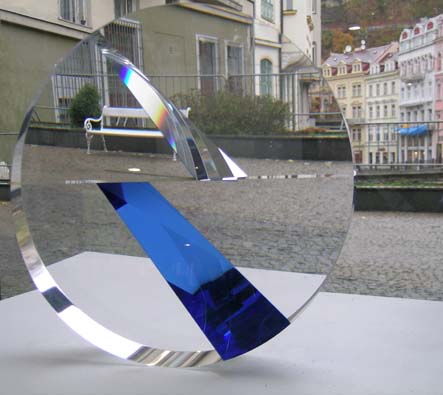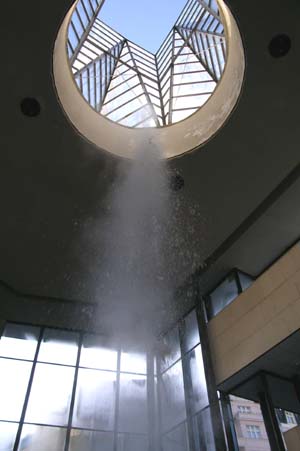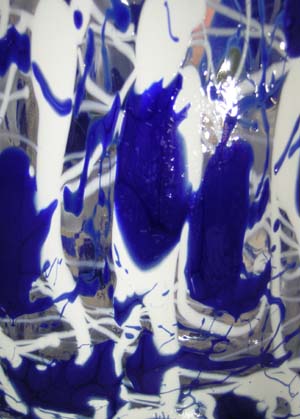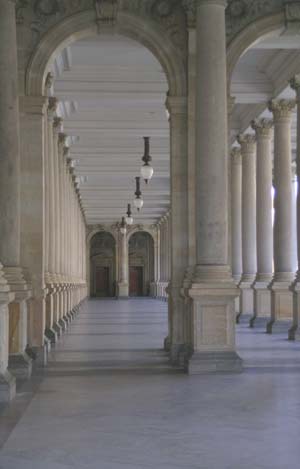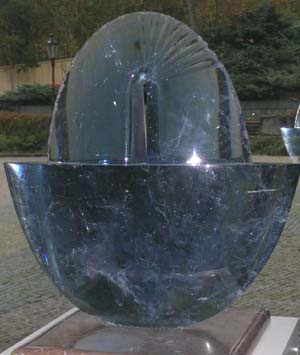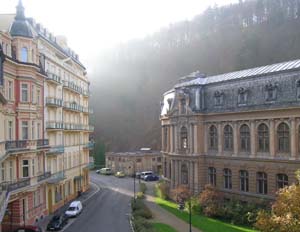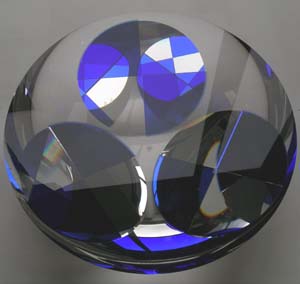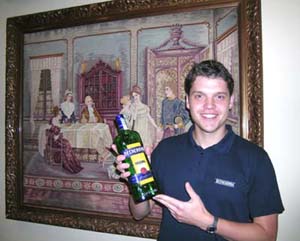Like
fine glass, this town came to prominence — fragile yet constant
in its beauty — through the fusion of historical events and
geographical circumstance.
Situated
in the western part of the Czech Republic, Karlovy Vary is named
after the Holy Roman Emperor Charles IV who founded the town in
1370. As legend would have it, he personally discovered the mineral
springs in this famous spa town while deer hunting in the region.
(Throughout history, the town has also been known as Karlsbad or
Carlsbad.)
In
addition to being the Holy Roman emperor, Charles was also the German
king and the king of Bohemia which is the region of the Czech Republic
in which Karlovy Vary is located. Educated at the French court,
he became Emperor thanks, in part, to the intercession of Pope Clement
VI. (Charles had promised the latter major concessions; however,
he would eventually gain the upper hand.)
This
was a period of great political instability throughout Europe which
was made even more critical by the scourge of The Black Death, the
bubonic plague that decimated the population. The pandemic not only
killed off about a third of the people but as historians and political
observers now realize, it almost destroyed the social fabric and
political-social institutions that made European society function.
A strong leader was badly needed, and that turned out to be Charles
who on Easter Sunday in 1355 was crowned Emperor in Rome; not by
the Pope himself, who was living in Avignon, but by the papal legate.
Charles's
connection with Karlovy Vary is befitting as well as symbolic because
his rule put an end to the years of conflict between popes and emperors
that had continually threatened the well-being of Europe. Charles
brought a cure to the problematic politics of the age, in particular
by ending papal interference in the Holy Roman Empire — a
victory of state over church and a healing of a different kind.
Charles
subsequently expanded his territories and eventually assured, by
bribing the electors, that the German crown would go to his son
Wenceslaus. From his imperial capital of Prague, he directed the
affairs of state in such a way that Bohemia flourished economically,
culturally, and politically. In fact, Charles succeeded in assuring
that Bohemia would gain internal autonomy, a rare power for any
region in Europe at the time. He also granted special privileges
to Karlovy Vary which for him represented an island of tranquillity
in imperial storms.
The
Spa town of Karlovy Vary also became a refuge from the rigours of
the affairs of state for many crowned heads and other nobility during
the 18th and 19th centuries. Foremost among these was the future
English King Edward VII who visited the region on numerous occasions.
And Karlovy Vary also hosted such eminent personages as Peter the
Great, Mozart, Beethoven, and Goethe. In the 20th century “American
cinematic royalty” such as Mary Pickford and Douglas Fairbanks
could be found in Karlovy Vary escaping the pressures of another
kind of public duty.
However,
given its strategic location in the heart of Europe, Karlovy Vary
would experience suffering of its own. By 1911, over 70,000 visitors
were making the pilgrimage to Karlovy Vary; and then came the "war
to end all wars." Even Karlovy Vary could not heal the catastrophic
wounds that the First World War visited upon Europe. The town's
"tourism" industry collapsed as did that of the Austro-Hungarian
Empire in which the town was then a part. At the end of that enormous
war of attrition, the Treaty of Saint Germain created a new nation
called Czechoslovakia much to the dismay of the German-speaking
majority of Karlovy Vary. Protests and more violence followed; during
a demonstration on March 4, 1919, six demonstrators were killed
by Czech troops.
But
despite the world's greatest hopes and best intentions, the Great
War was not the last. Another was to come. In 1938, Hitler's troops
occupied what was known as the Sudetenland (in the centre of which
was Karlovy Vary) and the Second World War was underway.
And
as the misfortunes of historical circumstances would have it, at
the end of that war Karlovy Vary and Czechoslovakia fell under the
heavy controlling hand of the Soviet empire. It would take another
44 years and a "Velvet Revolution" for that particular
burden to be lifted.
However,
despite the suffering and discord, peace and prosperity would return
to Karlovy Vary especially when the Soviet empire collapsed like
a house of cards; and Czechs and Slovaks would shook hands and go
their separate ways. But during the turbulent times the peaceable
and rehabilitative natural thermal waters of Karlovy Vary had continued
to flow.
Today
for the many visitors who once again take advantage of the hot mineral
waters of Karlovy Vary and its soothing cultural amenities, the
restoration of a vital state of being continues.
The
year was 1967, and Canada's centennial celebrations were underway
at Expo '67 in Montréal. The world had come to "Man
and His World." One of the most popular national pavilions
at this World's Fair was that of Czechoslovakia which had spent
$10 million dollars in constructing what most of agreed was the
most beautiful of them all. And inside the exhibits were astounding,
including the famous wood sculpture nativity scene from Trebechovice.
But it was the dazzling display of Bohemian crystal that everyone
was talking about. For us in North American, this was a first real
look at this wonderful Czech art form even though we were generally
aware that Czechoslovakia (as it was at the time) was well-known
for its glass works and its glass artists.
For
decades under the Communist régime, Czechoslovakia had been
off limits to the West but (although we did not know it at the time)
the glass artists of this nation had been resisting the socialist
realism art that the régime had been imposing elsewhere throughout
the country. In fact, the glass artists were continuing to create
very avant-garde works that showed considerable artistic courage,
abstract expressionism — and, of course, vision. They had
embraced glass as a fine art. Czech glass work ironically was a
major export that resulted in a strong Czech national identity.
One especially beautiful glass sculpture displayed in the Czech
pavilion was "The Glass Forest." Although Czech glass
and Czech artistic brilliance was there in Montréal for the
world to see, it would not be until the Velvet
Revolution in 1989 before these same artists appeared
again to the same extent on the world stage. It was a magical moment
in time.
And
another magical moment in time was our visit to the Moser company
in Karlovy Vary 17 years after the Velvet Revolution.
 To watch a brief video of the Moser
glass artists at work, click on the preceding video icon.
To watch a brief video of the Moser
glass artists at work, click on the preceding video icon.
The
Moser Factory and Museum in Karlovy Vary
In
North America, the spa "phenomenon" is a relatively recent
travel experience; and yet it is now one of the fastest growing
in the travel and tourism industry. Although the spa experience
is becoming more mainstream, on this continent it has usually been
seen as a "luxury" travel experience that emphasized beauty
treatments and general pampering. This is not the concept of the
European spa which was to a great extent the practice of alternative
and holistic health treatments. The spa experience also is not new
to Europe.
It
was Greek poet Homer who was one of the first to write about the
Classical Age of the spa when Greeks were enjoying extravagant and
extensive thermae. The Romans of course had various types
of baths often used by battle-weary soldiers to recuperate; but
soon became popular with the general public. One can also see similarities
and parallels to the famous European spas — of which Karlovy
Vary was perhaps the most important — in the onsen
and ryokens of Japan where bathing in hot mineral springs
was considered a health practice. And of course the Turkish hamman
has many of the same principles of health and healing.
In
"The New World," there have been similar sites such as
New York state's Saratoga Springs to which spa clients such as Franklin
Delano Roosevelt and Edgar Allan Poe retreated. And in Canada Banff
Springs in the glorious Rockies has been a mineral springs refuge
for a long time.
However,
the Golden Age of spas in Europe was the 18th and 19th centuries.
Despite political events that interrupted attendance at spas, it
has always been very much part of the culture. And now spa-going
in the Czech Republic is becoming even more popular as this nation
evolves into the new centre of Europe. This is especially evident
in what is know as The Spa Triangle which includes Karlovy
Vary, Mariánské
Lázne (Marienbad), and Františkovy
Lázne (Franzensbad).
